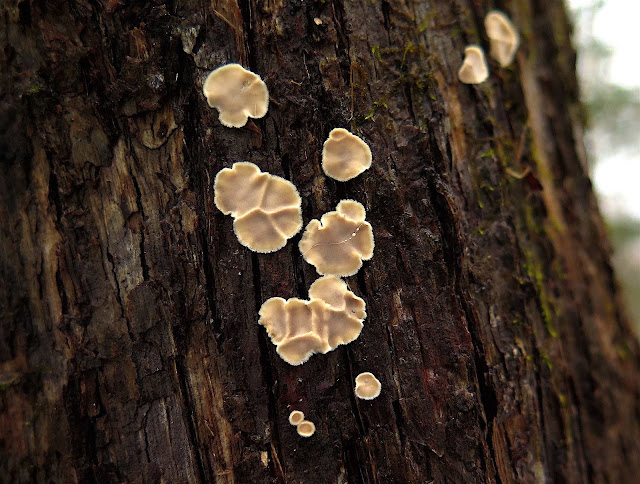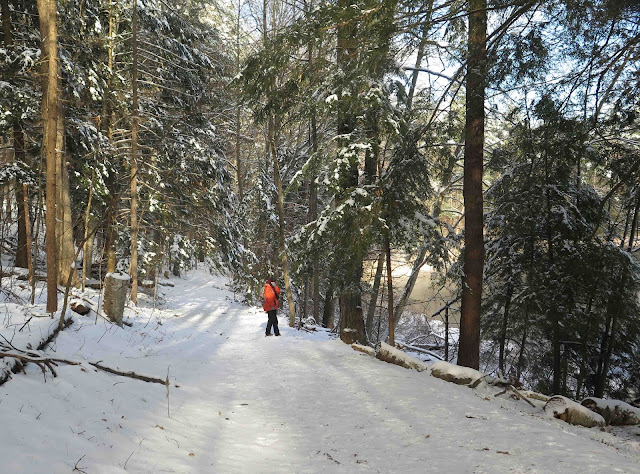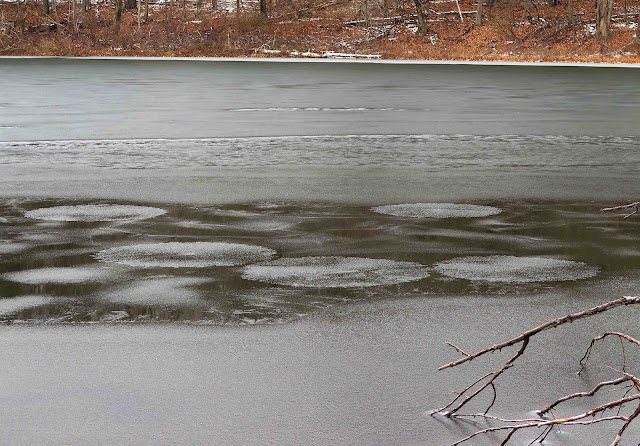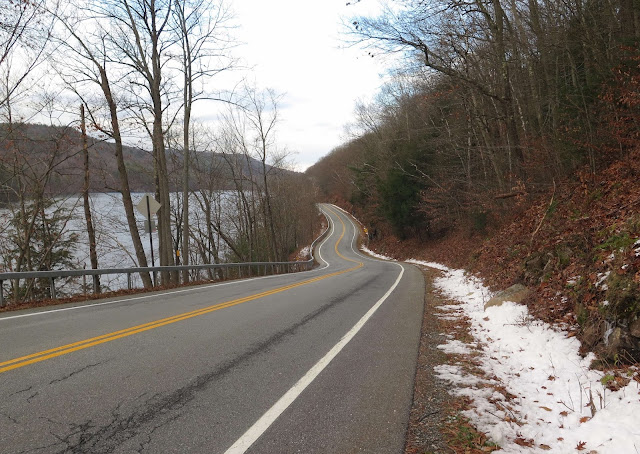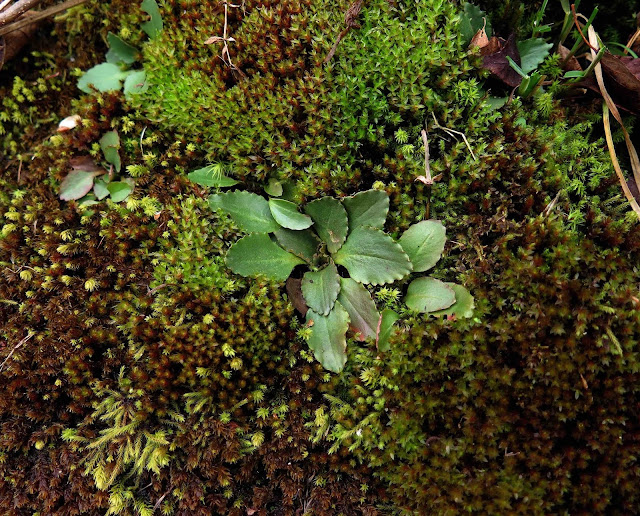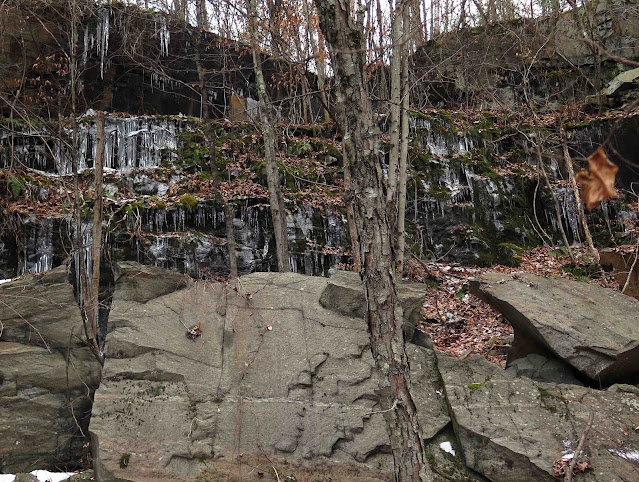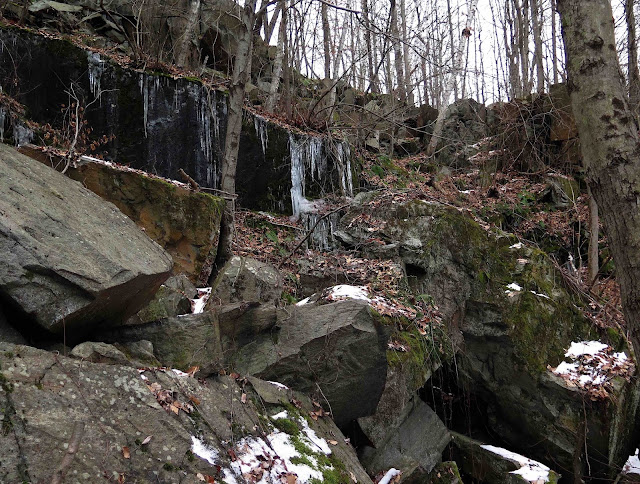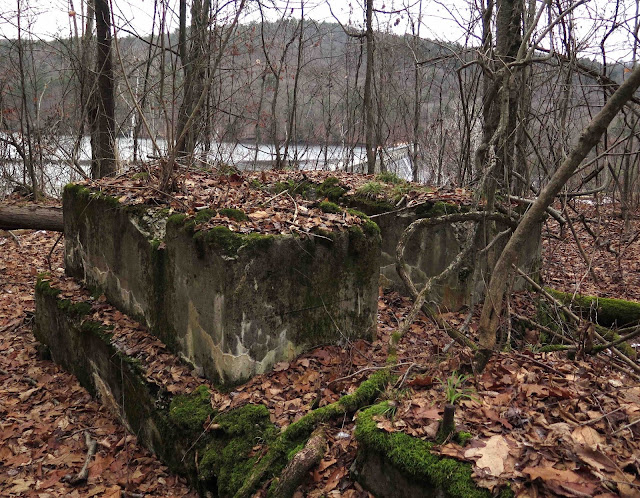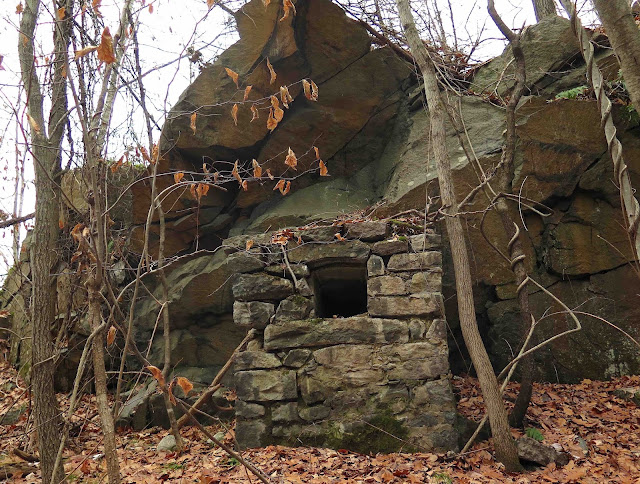So much for a white Christmas this year. More like a soggy and gray one. But that gray sogginess actually mirrored my mood, since once again as it did last year, Covid caused the cancellation of our plans for a festive gathering with family and friends. Oh well, at least those who fell ill were fully vaxed and boosted, so their symptoms were relatively mild. And so far, I have escaped it. But my mood stayed glum for so long, I finally decided I needed some woodsy, watery therapy to lift my spirits. So despite yet another gloomily-gray day, off I went yesterday to the Hudson River side of Moreau Lake State Park. And all I had to do was step from my car on the shore of the river to begin to feel peace and joy infuse my heart. Who wouldn't be soothed by such serene beauty as this?

Since the river's too cold to risk paddling now, I chose to walk a portion of the Cottage Park Trail, with its trailhead just across the road from the river. This trail takes its name from the remnants of now fallen buildings that once housed the workers who constructed the Spier Falls Dam on the nearby Hudson near the close of the 19th Century.
The buildings are long gone, but their stone foundations remain.
As Nature gradually repossesses these old stone foundations, the mosses that thrive on the rock are startling in their vibrant green beauty.
Some of the mosses still possess their spore capsules standing tall above their green leaves, impervious to winter's snowy cold.
As I set off through woods, I can glimpse the mountain range rising in the distance. This trail will eventually climb to the mountain heights, but I will confine my exertions today to the lowland woods, still colorful with the ruddy leaves of sapling American Beeches (Fagus grandifolia), which won't shed the old leaves until new ones sprout in the spring.
Other evidence of the beech trees' presence is scattered across the forest floor, with multitudes of spiky Beechdrops (Epifagus virginiana), a leafless flowering plant that obtains its nutrients from the roots of American Beech.
These small fleur-de-lys-shaped seed scales scattered across the snow are evidence of another tree species here in this woods, the Gray Birch (Betula populifolia).
I was surprised to see in this woods Gray Birches of a truly grand scale, since this birch species is rather short-lived and usually topples before it grows as large as a few I found growing here. The dark inverted Vs of the bark are one of the distinguishing marks of this species of birch, which often has bark as white as that of Paper Birch.
When I saw these small tan discs crowding together on a de-barked small treetrunk, I recognized them as the fungus called Hophornbeam Disc Fungus (Aleurodiscus oaksii). But since the bark was mostly shed, I could not distinguish the host tree as either a Hop Hornbeam or a species of oak. This fungus is known to grow on either tree species.
I found other fungi occupying fallen limbs that were lying about the forest floor, including this colorful patch of orange Stereum sharing its woody habitat with some beautifully green foliose lichens.
Another fallen limb held an abundant patch of the fungus called Tree Ear (Auricularia auricula). I believe it is obvious how this species obtained such a descriptive name.
Before the Cottage Park Trail starts to ascend the mountainous heights, it crosses an open area beneath the power lines that carry electricity produced by the hydroelectric Spier Falls Dam on the nearby river. The area under the powerlines is kept mowed to prevent trees growing into the wires, and this open area is home to many sun-loving native meadow flowers during the warmer months.
Round-headed Bush Clover (Lespedeza capitata) is among those sun-loving plants, and its brown spiky seedheads are easily identifiable even in the winter.
I continued on until the trail began to ascend, and the level terrain of the woods began to change to a steeper, rockier terrain. I recalled exploring this particular area last spring, when small creeks were tumbling down the mountainsides and the forest floor was covered with lovely wildflowers. (To see what this woods looks like in May, you can click
here. )
One of the plants I did NOT see last spring was the species that now dangled abundantly over the face of this gigantic rocky outcropping. What plant could that be?
I could not reach the dangling vines on foot, so I had to rely on my camera's zoom to show me a closer look at the still-green leaves sprouting from rosy-pink vines. The scallop-edged heart-shaped leaves do resemble those of Foamflower (Tiarella cordifolia), but I have never seen cascading vines of Foamflower draping across the face of a boulder like this. For sure, I must return next spring to see if I can confidently put a name to this interesting plant.
UPDATE: I have heard from a reader named Erik Danielsen, who assured me that this plant is indeed Foamflower, but he also argued that it is more likely the species called Tiarella stolonifera, which botanists now are arguing should be split off from the species T. cordifolia, due to its habit of regularly producing long stolons like those illustrated in my photo.
Other evergreen plants were abundant at this site, including the aptly-named Christmas Fern (Polystichum acrostichoides), which I recognized despite its distinctive Christmas-stocking-shaped pinnae being partially obscured. I was captivated by the curvaceous frond, with the points of the pinnae so sharply protruding from the snow.
I was surprised by how many people I met on this trail today, including several people who witnessed me down on my hands and knees peering at the underside of some fungi. And surprise of all surprises, these people recognized me from this blog, and were kind enough to tell me how eagerly they followed it and learned so much from it. My spirits were already high from simply having walked in this marvelous woods, but now they truly soared. I continue to keep this blog, if only for my own documentary purposes, but knowing that others learn from it is truly rewarding to me. Walking back to my car, I felt I was drifting along on Cloud Nine!
Back on the riverside, I lingered a while, feeling blissed-out by the serene beauty I beheld, even on this darkish day, growing darker now as the afternoon grew late.
I even found a few flower friends I could greet, including these still-lovely stalks of Meadowsweet (
Spiraea alba), their residual beauty enhanced by the riverside setting.
I was especially pleased to find these sturdy seed pods of Great St. John's Wort (Hypericum ascyron), rated a Rare species in New York but happy to grow in several sites along this stretch of the Hudson.
I stood for quite a while taking in this scene, of small rocky islands perfectly reflected in the still water and steeply forested banks receding in the distance, their dark shapes growing more misty with each bend of the river. Elated by the power of such serene beauty, I found it hard to leave.









